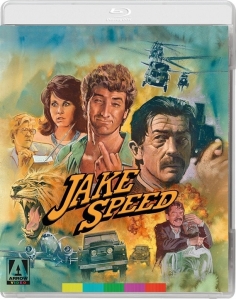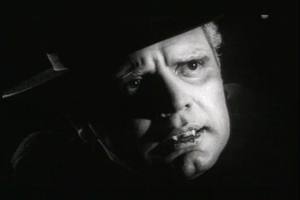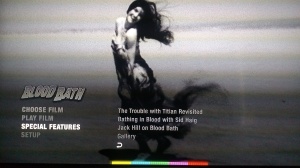EDGE OF SANITY (Blu Ray from Arrow Video) -original release 1989 . color. 85 minutes. Arrow U.S.Blu Ray release June 21,2022 . NTSC Widescreen 1.85:1 Region A s.r.p. $ 39.95
During the 1970s and 1980s, Anthony Perkins gave amazing performances on film (FFOLKES, Universal,1980 ), television (LES MISERABLES, CBS,1979 ; THE GLORY BOYS ,Yorkshire TV,1984) and on stage ( magnificent on Broadway as Dr Dysart in EQUUS,1975).

Yet, even with his wide body of work , he was still stalked by his own creation, that of the cinematic ideal of Norman Bates in Hitchcock’s masterpiece PSYCHO (Paramount) . So powerful and indelible was his portrayal that he could not escape it.

He accepted that was to be how people would see him and so he did two theatrical and one tv sequels, as was as spoofing himself on tv on Saturday Night Live to promote one of them. Thus, the remaining ten years of his life were mostly variants of his twitchy Norman Bates persona.


One of the better ones was in Ken Russell’s CRIMES OF PASSION (New World ,1984, , available on Blu Ray from Arrow ). Five years later, he added Norman to EDGE OF SANITY, adding it to a retelling of The Strange Case of Dr Jekyll & M Hyde by Robert Louis Stevenson(1886) and a Jack The Ripper variant. In some territories, the film was known as DR. JEKYLL & MR. HYDE.

In EDGE OF SANITY , sex & cocaine are mixed into the formula of this 1880s set thriller. A young boy witnesses a couple having sex but is soon discovered & beaten for his voyeurism. During the beating , the young boy imagines the woman laughing at him is covered in blood . This is shown to be a dream memory , as an adult Dr Jekyll awakes in a sweat. His wife asks him if anything is wrong ,but he shrugs her away and, grabbing his cane, walks down to his laboratory.

Dr Jekyll (Perkins) has been working on an experiment to explore the human personality. To that end , he mixes unknown chemicals with cocaine and ether . The experiment seems to work, as he becomes a twisted , stringy haired paler faced version of himself who calls himself Edward Hyde. This new persona is also stronger, & no longer needs his walking stick ,though he makes other uses for it during the film.

Freed of his inhibitions, he goes down to the Whitechapel area of London. Hyde enjoys the pleasures of the bars & brothels ,too much so . His encounter with a prostitute result in him killing the woman. From then on, it is a sleazy mix of sex & violence.

Director Gerard Kikoine was better known for his soft porn & hardcore output . His work must have been stylish ( he did work with Radley Metzger, the auteur of soft & hardcore cinema ) since it caught the attention of Harry Alan Towers. Towers was a master of putting together international deals and getting recognizable names to appear in them. He collaborated again with the director & composer for the film BURIED ALIVE (21st Century, 1989), a film notable as the last film that John Carradine directly worked upon.

Mixing Jekyll & Hyde with Jack the Ripper is not new. During the actual Ripper Murder spree ( April to November 1888). actor Richard Mansfield was portraying the dual role of Dr Jekyll & Mr. Hyde . He began the role in 1887 in his own adaptation of the story just 1 year after the story was published.

Mansfield in his adaptation made many of the changes still carried over into most adaptations since his play, including adding women to the piece, Dr Jekyll being a sympathetic character , and increasing the presence and importance of the law in the character of Inspector Newcomen. The show was a huge hit in its initial Boston & New York performances . Mansfield took his production to the Lyceum Théâtre in London. It too was well received ,at first. Then the Ripper killings began. Mansfield’s onstage transformation into the murderous Mr. Hyde had several of the more gullible convinced that he could not be able to portray such a character unless he himself was a dual personality, and possibly the Ripper himself! The terrible comments affected the box office & Mansfield closed the production. He did continue to play the roles on & off for almost two decades , including several Broadway revivals. He died on August 30,1907 at age 50.

Hammer Films mixed the two stories of Jack with Jekyll & Hyde while throwing in some Burke & Hare in their gender swapping Dr Jekyll & Sister Hyde (Hammer/AIP ,1971). This could have been a disaster or poor sex farce but the clever script by Brian (tv’s Avengers series)Clemens, skillful direction by Roy Ward Baker, beautiful top notch production design and cinematography, and the wonderful performers make this a sadly neglected Hammer gem.

EDGE OF SANITY was not as well crafted. It received mixed to negative reviews. It really did not find its audience until its release to home media , first by Virgin Video then in ep speed by Video Treasures. Both were cropped & foggy looking, the latter with increased grain.

MGM released a much better print on DVD , which was cropped on one side of the disc, & widescreen on the other (did anyone ever watch the cropped copy on these DVDS willingly?).

Now , Arrow continues finding and restoring obscure films for rediscovery and reappraisal.
First , they went to the original 35mm (remember 35mm ?) camera negative , cleaned it up and gave it a brand new Hi Def 1080p restoration. The difference is quite evident when watched in comparison to the MGM DVD. There seems to be more screen image on the side of the frames (1.85:1) , and the clarity, sharpness and colors really are superior to the older release.

The sound is also superior to the older prints. Perkins at times whispers his lines when not taking the crazy to eleven, and you ended up adjusting the levels throughout. Now, even his lower spoken lines are clear and audible. LPCM 2.0 stereo.
Just in case, there are easy to read SDH English subtitles .
There is an informative running commentary by filmmakers David Flint & Seth Hogan .
Other extras on this disc include :
Over The Edge – new interview for this release with Stephen Thrower, author of NIGHTMARE USA (FAB PRESS,2007).

Jack, Jekyll, & Other Screen Psychos – a new interview for this release with Dr Clare Smith, who wrote JACK THE RIPPER IN FILM & CULTURE ( Palgrave/MacMillan,2016)
Both interviews compliment each other, one covering the film , the other the fascination we have with Jack The Ripper.

TWO Interviews with the director
French Love- Gérard Kikoïne discusses his career
Staying Sane– the director focuses on EDGE OF SANITY
There is also an original theatrical trailer.
Not included with the review copy is the magnificent Graham Humphreys slipcover with reversible artwork.
Also not included with the review copy is film critic & film historian (Candyman (Auteur, 2018)) Jon Towlson’s illustrated collective booklet(included with first pressings only!)

I must admit watching this new release has given me a better appreciation of the film. For example, the score by Frederic Talgorn (it seems to have been his first) is lush and orchestral in a time when cheap synth scores were more the norm. Ditto too the cinematography by Tony Spratling is sharp and makes effective use of color in a style which hints at Argento. The costumes are good , though one character who plays a pimp looks like he just stepped out of a Culture Club music video . The Bucharest locations make the film look like a much bigger production than it really was .

Perkins sadly would pass away September 12, 1992, at age 60 . Perkins himself led a dual existence, having to hide his real personality ,and undergoing psychoanalysis to “cure” himself. He married actress Berry Berenson, had two sons , & were happy , though he could not deny who he was.
In 1990 , the sleazy National Enquirer gained access to a blood sample that Perkins had given in an unrelated test , and they sprayed the news ‘Psycho Star Has AIDS’. This is how the actor himself found out that he was infected. Before he passed , he issued this public statement :
“There are many who believe this disease is God’s vengeance. But I believe it was sent to teach people how to love and understand and have compassion for each other. I have learned more about love, selflessness and human understanding from people I have met in this great adventure in the world of AIDS, than I ever did in the cutthroat, competitive world in which I spent my life.”

Worth getting for fans of Anthony Perkins or / and the works of producer of Harry Alan Towers and those interested in Jack the Ripper, Jekyll & Hyde , and eighties horror.
–Kevin G Shinnick–
If you would like to contribute to
SCARLET THE FILM MAGAZINE,
contact Kevin at
Please follow SCARLET THE FILM MAGAZINE
here
https://scarletthefilmmagazine.wordpress.com
and on Facebook
https://www.facebook.com/SCARLETreviews
































































































































































